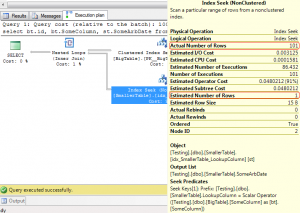I saw this one on a forum recently and it’s a fun question to look into.
When running CheckDB on an in-use database, sometimes messages like the following will appear in the SQL error log
1 transactions rolled back in database ‘Testing’ (8). This is an informational message only. No user action is required.
DBCC CHECKDB (Testing) WITH no_infomsgs executed by theAdmin found 0 errors and repaired 0 errors. Elapsed time: 0 hours 0 minutes 31 seconds.
What’s going on here? Why is checkDB rolling transactions back?
Well, the truth is, it’s not rolling anything back.
When CheckDB runs it has to be able to get a consistent view of the database, one without half-done transactions, without data modifications in progress. On SQL 2000 (and earlier), CheckDB used the transaction log to get that consistent view. It would read through the transaction log to see what had been done to the various structures in the database. In SQL 2005 this was changed and CheckDB now uses the database snapshot feature to get its consistent, point-in-time view of the database.
Database Snapshots
A database snapshot is a read-only, point-in-time copy of a database. It uses a combination of sparse file and copy-on-write technology to reduce space usage and, as a result, it’s usually much smaller than the database it was based on.
When a snapshot is created, any open transactions are rolled back within the context of the database snapshot to generate the consistent, point-in-time copy. This generates messages in the SQL error log stating how many transactions were rolled back
CheckDB
The first thing that CheckDB has to do is to create an internal, hidden database snapshot to get the consistent view of the DB that it needs. It will do this unless it’s run with the TABLOCK option. When the snapshot is created, any open transactions will be rolled back but only in the context of the snapshot, not in the context of the actual database. CheckDB will then run against the snapshot and will drop it once complete.
So the answer to the question of why checkDB is rolling back transactions is a simple one. It isn’t.

